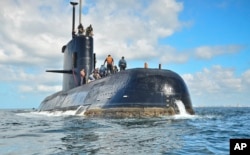The Argentine navy said Thursday that a possible explosion had been heard in the ocean not long after one of its submarines went missing with 44 people aboard.
The ARA San Juan disappeared November 15, and the Argentine navy described the explosion that followed near the sub's location as "anomalous, short, violent."
The U.S. Navy and an international nuclear test-ban monitoring organization said the "hydroacoustic anomaly'' was produced just hours after the navy lost contact with the submarine.
Enrique Balbi, spokesman for the Argentine navy, said officials did not know what caused the explosion and that there was no evidence the vessel had been attacked. He said the search would continue until there was full certainty about the fate of the San Juan.
The San Juan, a 34-year-old German-built, diesel-electric submarine, had reported a battery problem on November 15 and said it was diverting to its home base at Mar del Plata, but did not send a distress signal, according to the navy.
Assuming that the submarine remained intact after the blast and settled to the ocean floor, the ship had only a seven-day supply of oxygen, which might have run out Wednesday.
The weeklong search has focused on the sub's last known position, about 320 kilometers off the Argentine coast, but has been hampered by bad weather.
Russia on Thursday became the latest country to send navy specialists and analysts to areas off the coast of Argentina to assist in the search for the San Juan.
The U.S. Navy has also sent underwater search vehicles and two undersea rescue systems to help with the effort.
The 2,000-tonne submersible uses diesel engines on the surface and battery-powered electric motors underwater. At the surface, the German-built ship's four diesels can charge the batteries.









